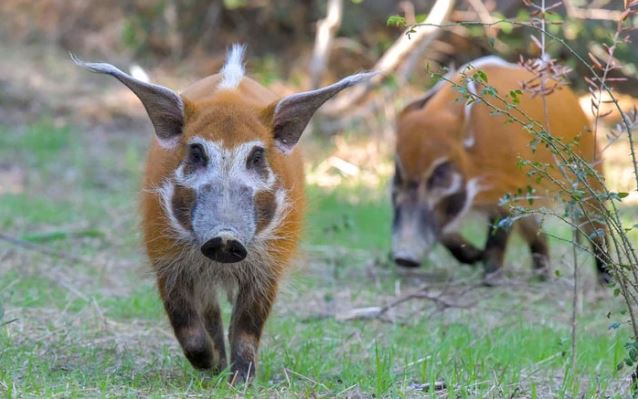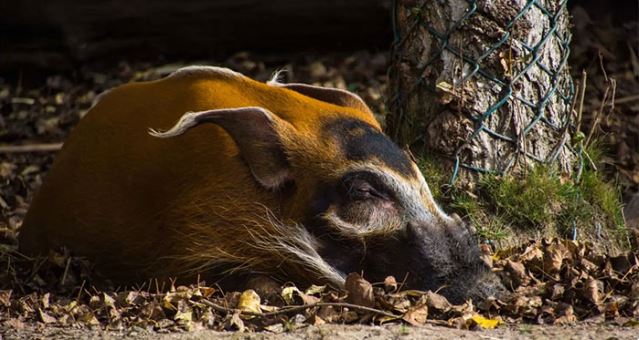The Red River Hog (Potamochoerus porcus), known for its flamboyant appearance and captivating personality, stands out as one of the most visually striking members of the wild pig family. Native to the dense forests and wetlands of West and Central Africa, this remarkable species captivates both researchers and wildlife enthusiasts with its vibrant coloring, unique behaviors, and ecological significance. Let us delve deep into the fascinating world of this truly handsome pig of nature.
The Distinctive Appearance of the Red River Hog
The Red River Hog is instantly recognizable thanks to its brilliant reddish-orange fur, which gleams under the sunlight in its natural habitat. This lustrous coat is complemented by a striking white dorsal stripe that runs down the spine, enhancing the creature’s already impressive profile.
Adult individuals feature prominent white markings around their eyes, cheeks, and jawline, offering a stark and photogenic contrast to the darker coloration around the snout and forehead. These facial features are especially pronounced in dominant males, whose faces are adorned with thick facial warts and extended tusks—both essential tools in combat and status signaling within groups.
Adding to their dramatic look is the long, flowing beard that hangs from the jaw and the pronounced tufts of hair on the ears. These features not only serve as identifiers among individuals but are also believed to play a role in sexual selection and social hierarchy.
Habitat and Geographic Distribution
The Red River Hog thrives in a variety of humid environments, particularly favoring lowland rainforests, swamps, savannas, and regions near rivers and wetlands—hence the name. Their range extends across several African nations including Gabon, Cameroon, the Congo Basin, and parts of Guinea and Nigeria.
These regions provide an ideal mixture of dense vegetation and access to water, which the hogs rely on for foraging and thermoregulation. Their natural habitat is essential to their dietary habits, social structures, and reproductive success.
Feeding Behavior and Diet
Highly omnivorous and opportunistic, the Red River Hog employs a versatile diet that allows it to adapt to seasonal changes and habitat variation. These animals primarily feed on:
- Roots, tubers, and bulbs
- Fruits and berries
- Grasses and leaves
- Insects, snails, and small reptiles
- Carrion and eggs of ground-nesting birds
One particularly intriguing dietary habit includes their attraction to the seeds of the Boko tree (Balanites wilsoniana)—often consumed after passing through the digestive systems of elephants. This demonstrates a complex ecological relationship, where Red River Hogs benefit from the foraging behavior of other large mammals.
Their snouts are highly muscular and mobile, acting as natural shovels to dig through forest soil in search of edible items. This foraging behavior also contributes to soil aeration and seed dispersion, showcasing their role as vital ecosystem engineers.
Social Structure and Group Behavior
Red River Hogs are highly social animals, typically forming small groups known as sounders. These consist of 6 to 10 individuals, often led by a dominant male and composed of several females and their young. However, in food-rich areas or during mating seasons, larger aggregations can form temporarily.
The dominant male is easily recognizable, not only by his larger size but also by his impressive tusks and facial shields, which serve both in defensive displays and real combat against rival males. These territorial confrontations are usually resolved through intimidation, but physical altercations can occur during the peak of the breeding season.
Communication within the group includes a wide range of vocalizations, grunts, squeals, and body postures, emphasizing their highly developed social bonds.
Breeding Season and Reproductive Traits
The reproductive season of the Red River Hog is closely tied to rainfall cycles, typically occurring from September to April, with peak mating activity during the wettest months between November and February.
Following a gestation period of approximately 120 days, the female gives birth to 3 to 4 piglets in a well-hidden nest made of leaves and grass. Newborns weigh between 650 to 900 grams and are covered in dark brown fur adorned with creamy white stripes and spots, providing effective camouflage in the underbrush.
Piglets remain hidden in the nest for several weeks, under the vigilant protection of their mother. As they grow, their coat gradually shifts to a uniform reddish hue by the age of 6 months, signaling the transition into sub-adulthood. They reach full sexual maturity around 2 years of age.
Defensive Strategies and Predators
Although not apex predators, Red River Hogs are formidable when threatened. Their main natural predators include leopards, hyenas, and large snakes such as pythons. In defense of their group, dominant males use their tusks, speed, and strength to confront attackers directly.
These pigs also possess a keen sense of smell and acute hearing, which allows them to detect danger long before a predator gets too close. Their agility and ability to dive into dense undergrowth or swim across water bodies make them difficult to pursue.
Ecological Importance and Conservation Concerns
While currently listed as Least Concern on the IUCN Red List, Red River Hogs face growing threats from human encroachment. Habitat destruction due to agriculture, logging, and the bushmeat trade are placing increasing pressure on local populations.
Despite their adaptability, these hogs are becoming more vulnerable in fragmented ecosystems where migration routes are blocked and food sources are diminished. Conservation efforts must prioritize preserving forest corridors, restricting unsustainable hunting practices, and raising awareness of their ecological role.
Why the Red River Hog Deserves the Spotlight
The Red River Hog is not merely the most handsome pig in nature, but also a vital component of African ecosystems. Its flamboyant appearance is matched only by its importance as a seed disperser, soil renovator, and prey species that maintains balance within the food chain.
Moreover, their intricate social lives, adaptive feeding strategies, and striking looks make them a species worthy of admiration and protection. Through education and sustainable conservation policies, we can ensure that future generations will continue to be enchanted by the vivid colors and charismatic charm of the Red River Hog.
Tags: Red River Hog, African wildlife, handsome pig, wild boar species, Potamochoerus porcus, rainforest animals, African forest pig, red pig, bush pig, animal biodiversity, wildlife conservation.




